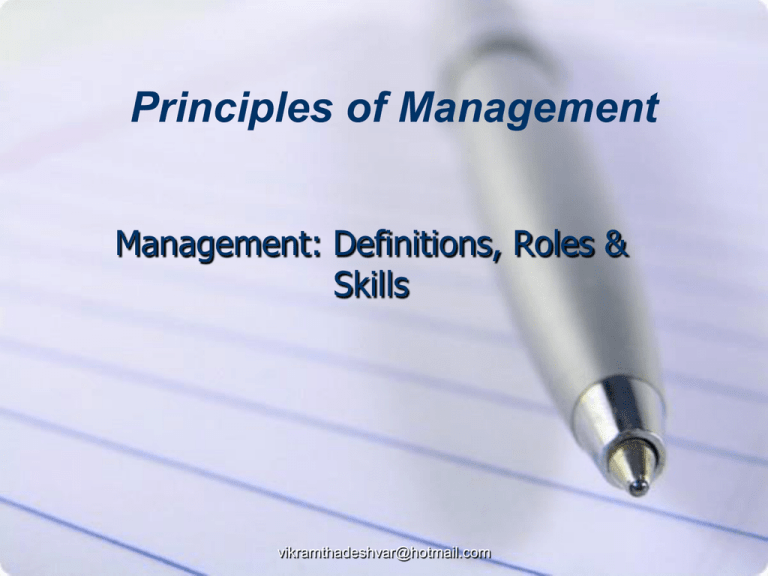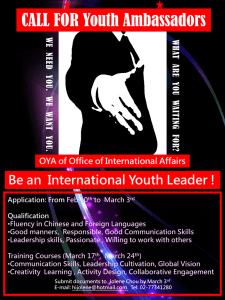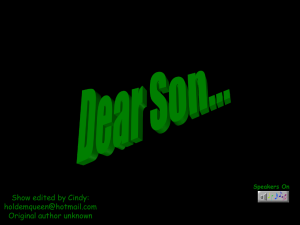Management - Ayo Menulis FISIP UAJY
advertisement

Principles of Management Management: Definitions, Roles & Skills vikramthadeshvar@hotmail.com Management: Definitions “Management is the process of designing and maintaining an environment in which individuals, working together in groups, efficiently accomplish selected aim(s) viz. to create a surplus(s).” …. Weihrich & Koontz “Management is not an absolute; rather it is socially and culturally determined. Across all cultures and in all societies, people coming together to perform certain collective acts encounter common problems having to do with establishing direction, coordination and motivation. Culture affects how these problems are perceived and resolved.” …The Art of Japanese Management by R. Pascale & A. Athos . vikramthadeshvar@hotmail.com Management: Definition …ctd. Applies to and through any kind of organization Applies to Managers at all levels Concerned with “Doing the right things right at all times”: 1. Effectiveness: Achievement of objectives (Right Things); 2. Efficiency: Achieving those objectives with least amount/ sacrifice of resources (Things Right); 3. Continuous Improvement: in creating increasing ‘surplus’ (at all times); – “Improve or die” = survival of the fittest – “what gets measured, gets managed and improved” e.g. Productivity= Output / Input ratio Collective, cohesive and consistent human effort towards accomplishing a common objective. vikramthadeshvar@hotmail.com Management: Definition …ctd. Additionally, Managers need to factor in external environmental forces: Political Economic Societal Regulatory Organization Globalization Technological For maximum benefit to the organization vikramthadeshvar@hotmail.com Management: Roles & Skills Management - what managers do: Fredrick Taylor’s path-breaking “scientific approach” Henri Fayol’s classical definition of ‘functions’, now modified to: Mintzberg’s map of managerial ‘roles’: Interpersonal + Informational + Decisional Katz’s interpretation of ‘skills’: Plan -- Organize -- Lead(Command&Coordinate) -- Control Technical / Human / Conceptual Management – ‘get things done through others’: Leadership: “The ability to influence a group towards achievement of goals”. Motivation: “The willingness to exert high level of effort towards goals” Communication:”The transference and understanding of vikramthadeshvar@hotmail.com meaning” Management: roles & skills …ctd. Managerial Roles (Mintzberg) Role Interpersonal •Figurehead •Leader •Liaison Description Examples symbolic head; required to show ‘face’ in social & legal conditions. Motivating & directing subordinates Networking outside for information & favours Ceremonial, Civic etc. project plan Industry group meets Informational •Monitor •Disseminator •Spokesperson nerve centre and interpretator Reports networking within the organization Meetings etc. Transmit intent to outsiders; expert Board Meets Decisional •Entrepreneur •Trouble shooter •Resource allocator •Negotiator Opportunity finding& reacting Handling unexpected disturbance Initiating/approving changes vikramthadeshvar@hotmail.com Getting best deal for Organization Strategy Plan Contingency Budgeting Contracts Management: roles & skills Managerial Skills(Katz & others) Technical Skills: Skills Needed Application of specialized knowledge or expertise acquired though formal training & its use. Human Skills: Ability to work with people, understand and motivate groups & individuals. Board Exec. Mgr. Conceptual Skills: Mental ability to recognize, analyze, diagnose and think through complex situations. Supr. vikramthadeshvar@hotmail.com Principles of Management 2 Management: A Systems Approach vikramthadeshvar@hotmail.com Systems approach to Management ENVIRONMENT input Transformation process output Feedback (Reenergizing the system) System Boundary Organization as a System receives Input, transforms it through a Process for Output and Operates in an Environment (economic, regulatory and other forces) vikramthadeshvar@hotmail.com Systems approach to Management …ctd. Systems Concepts System Boundaries and Subsystems > Systems often consist of numerous subsystems. > Each subsystem has elements, interactions with other subsystems, and objectives. > Subsystems perform specialized tasks for the overall system. Subsystem Interfaces and Interface Problems Sub-System 1 Sub-System 2 Sub-System 3 vikramthadeshvar@hotmail.com Systems approach to Management …ctd. Outputs and Inputs Systems produce Outputs from Inputs – i.e. the Inputs are converted to Outputs. Outputs of one subsystem become inputs to another subsystem. Outputs must adhere to standards to be useful or acceptable to the next subsystem. System Environment Environment consists of people, organizations and other systems that supply data to or that receive data from the system Managers at different levels perceive ‘Environment” vikramthadeshvar@hotmail.com differently Systems approach to Management …ctd. “Inputs”: 5 Ms of Management Inputs or the resources managers deal with are: Man: human resources, both inside and connected with an organization; Materials: goods (hard & software, processed or semifinished) and services required to create the sellable end product; Machines: technology and expertise deployed towards the transformation process; Methods: systems, procedures and processes seamlessly put together for the transformation; Measurement: score-keeping and in-process monitoring continuously with due feedback to keep on-course on time. “Money” is required for generating all theses Ms – managers need to acquire, deploy, generate and vikramthadeshvar@hotmail.com distribute money as a primary need for business! Systems approach to Management …ctd. Output for “Stake-holders” in Business: “Stake”: Something wagered or risked; an interest in an enterprise with contingent gain or loss …Webster ‘s dictionary “Holders” who have stake in Business: Shareholders: are the owners. They have put in their money in the enterprise, expecting better returns from it than from other ventures; Society: includes the State, provincial and local governments for the improvement of ‘quality of life’ of its citizens; vikramthadeshvar@hotmail.com Systems approach to Management …ctd. Output for “Stake-holders” in Business …ctd. Suppliers: continuity of their enterprise depends on the success of the customer enterprise; Customers: require the goods and services provided by the enterprise, better than than those from its competitors. The enterprise is, in turn, a supplier to its customers; Employees: livelihood depends on the progress and success of the employing enterprise; There is a “freedom of choice” (for association) between each of these stake-holders and the enterprise in the longer term: But they sink or swim together in the shorter term Length of term definition varies with individuals! vikramthadeshvar@hotmail.com Systems approach to Management …ctd. Management as a system transforms inputs: by the process of Planning + Organizing + Staffing + Leading + Controlling to accomplish certain pre-determined, (as derived from stakeholder needs) goals or objectives vikramthadeshvar@hotmail.com Systems approach to Management …ctd. Stakeholders Shareholders; Society; Customers; Employees; Suppliers Man, Machine Material, Method, Measurement Controlling Leading Staffing Organizing (Goal Oriented) Planning Inputs Product/Services, Profits, Customer & Societal satisfaction, Other Long-term Goals Stake holder Feedback (reenergizing the system) vikramthadeshvar@hotmail.com Constraints) EXTERNAL ENVIRONMENT(Opportunities, Outputs (External To Orgnzn.) Principles of Management 3 Management Process First Step: Planning vikramthadeshvar@hotmail.com Planning Planning involves selecting objectives or goals and the course of actions to achieve them: Provides the bridge to take us from where we are to where we want to go; Is a rational approach to achieving preselected objectives - based on innovation, knowledge and purpose; Decision making in choosing the best from alternative courses of action and is integral to planning; vikramthadeshvar@hotmail.com Plans as foundation of Management What kind of resources needed? What kind of people & org. structure to have? Plans How to lead them to reach planned goals? How to control in case of deviation from plan ? Thevikramthadeshvar@hotmail.com primacy of Planning Types of Plans Mission / Purpose The basic function or ‘reason for existence’ of an enterprise/ organization Case in point: Mission of Indira Institute “To train our students to become the best business minds and entrepreneurs today, who will lead their companies successfully into the future tomorrow , locally, nationally and globally.” vikramthadeshvar@hotmail.com Type of Plans (Cont’d) Objectives/ Goals The end towards which activity of an organization is aimed, e.g. For a Business enterprise – profit, surplus creation; For a Management Institute: The number of employable/useful trainees; Strategies Determination of the long term objectives and adoption of a course of action Gives a frame work for linked action-plans, communicated systematically to guide thinking and actions. vikramthadeshvar@hotmail.com Types of Plans (cont’d) Policies “Plans” that are general directional statements (or understandings) that guide/help in decision making: Repeat decisions taken ‘reflexively’; Delegation of tasks without loss of control. Some discretion is permissible depending on circumstances thus encouraging initiative within limits and situational adjustments; Issues with “Policy” Seldom documented in writing Subject to interpretations vikramthadeshvar@hotmail.com Types of Plans (cont’d) Procedures Plans that are chronological sequences of required actions: task-oriented in nature; Cuts across department boundaries (subsystems) in an organization: e.g. customer complaint handling procedure; Procedures and policies are inter related: e.g. authorization for paid leave Policy governs quota, responsible authority etc. Procedure governs application, grant and record-keeping. Rules Specific actions or non-actions allowing no discretion Caution: rules vikramthadeshvar@hotmail.com (and procedures too) limit initiative! Types of Plans (cont’d) Programs Action plans (mainly non-routine or for changed activities) including, task assignments, steps to be taken, resources to be deployed etc. to achieve a (new/renewed) goal; Primary program may require supporting programs, spreading across the enterprise; Perfect coordination between supporting & primary programs essential to avoid delays, unnecessary costs and expected roll-out. Programs are a complex of (sub)goals, policies, rules and other elements necessary for the course of action e.g. obtaining ISO certification. vikramthadeshvar@hotmail.com Types of Plans (cont’d) Budgets A statement of expected results expressed in “Numerical terms” e.g. financial operating budget = “profit plan”; Budgets enforce precision in thinking: Making a budget is ‘planning’ by itself; Encourages innovation – a “different” way to work Budgets serve for ‘Control’: Enforces discipline in execution of plans; Instills cost consciousness; Makes people (constantly) plan! vikramthadeshvar@hotmail.com Steps in Planning Being aware of challenges Market, Customer’s wants, Competition, Own strengths & weakness Setting Goals/ Objectives What to accomplish & when Budgeting (Numberizing Plans) Planning premises Identifying alternatives Internal & external Environment/conditions Formulating Supporting plans Comparing & choosing an alternative e.g., Sales budget e.g., plan to buy Decision Operational Expense budget, Equipment, recruit & train making vikramthadeshvar@hotmail.com Capital expenditure budget Employees, develop product etc The Planning Process Planning Period: Short range plans e.g. material procurement plan in a factory Long range plans e.g. product development plan, plant/production facility installation; “Urgent” drives out the “Important” – mismatch between short & long term plans! Planning horizon must allow for actions to run their course – requiring ‘commitments’: Thus “decisions today” are key to good plans; Long-term plans reap benefits of good shortterm plans. vikramthadeshvar@hotmail.com Steps in Planning Being aware of Opportunity Considering, Market, Competition, Customer’s wants, Own strengths &weakness Setting Goals/ Objectives What to accomplish & when Objective = Important end towards which activities are directed; therefore needs verification at the end of the plan period. vikramthadeshvar@hotmail.com Hierarchy of Objectives& Org. Levels Board of Directors Mission Overall Objectives & Key result areas. CEO Division Head Product X Divisional objectives Departmental objectives Individual objectives Sales & Mktg Dept Sales Manager A Division Head Product Y Production Dept Sales Manager B Objectives set end results – they need to be supported by a hierarchy of sub-objectives, duly networked through the organization to avoid vikramthadeshvar@hotmail.com discord and wasted effort. Hierarchy of Objectives& Org. Levels …ctd. The Organizational Objectives is deployed into the objectives of : Divisions Departments Individual objectives; The ‘cascade’ principle: seamless flow; Mutual support & interlocking of goals is essential Managers must ensure that the components of the network fit each other; Departments/divisions can be ‘blind-sided’. vikramthadeshvar@hotmail.com Hierarchy of Objectives& Org. Levels …ctd. Top-down Approach Mission Overall Objectives & Key result areas. Divisional objectives Bottom-up Response: The result Departmental objectives Individual objectives While setting Objectives, ideally, Top Management should get information / ‘buy-in’ from lower levels to set realistic goals for a good result. vikramthadeshvar@hotmail.com Key Result Areas (KRA) Are areas in which performance is essential for the success of an enterprise Examples of ‘generic KRA’s: Market share Return on Investment (ROI) Service level Customer satisfaction Peter Drucker recommends: Market standing, innovation, productivity, physical & financial resource, profitability, managerial performance & development, worker performance & attitude and public responsibility. vikramthadeshvar@hotmail.com Management By Objectives (MBO) A comprehensive managerial system that integrates many key managerial activities in a systematic manner and that is consciously directed towards the effective and efficient achievement of organizations’ and individual objectives: Set-out by Peter Drucker in 1954; Integrated to personal performance appraisal by Douglas McGregor in 1957; Has formed the basis for many theories on motivation; Has been criticized for introducing a short-term focus and undesirable behaviour; Currently viewed as a ‘way of managing’ – not a specific vikramthadeshvar@hotmail.com tool. Weaknesses of MBO Emphasis on: short term at the expense of long term “Results” over “Process” Individual over collective effort Failure to grasp and deploy the concept of “seamless cascade” Difficulty in setting agreed, harmonized goals Danger of inflexibility vikramthadeshvar@hotmail.com Planning Premises & Strategies Setting Goals/ Objectives What to accomplish & when Planning premises Identifying alternatives Internal & external environment Comparing & choosing an alternative Decision making Strategic Planning Process Strategy = determination of the purpose / the basic long-term objectives; the adoption of courses of action and allocation of resources required to achieve the aims. vikramthadeshvar@hotmail.com Planning Premises & Strategies …ctd. Stakeholder Wishes & Shareholder demands Management Orientation Current External situation Enterprise Profile Purpose & Major objectives of enterprise Forecast External situation Current resource situation External Opportunity & Threat Key success factors & Alternative Strategies Internal Strengths & Weakness The Strategic Planning Process vikramthadeshvar@hotmail.com Strategic choice Planning Premises Porter’s Five Forces : an Model for analysis of the Externals environment. vikramthadeshvar@hotmail.com Planning Premises: forecast of demand Estimate of future demand is made by qualitative methods, timeseries methods and/or causal methods: Qualitative relies on judgement of experts to translate to quantities; Time-series statistically interpolate demand on historical data; Causal method seek co-relation on cause and effect basis between two (or more) variables to quantify demand; However, all forecasting methods are limited by: Handling of un-quantifiable factors e.g. national pride Unrealistic assumptions fuelled by a desire to succeed Excessive data required (often unobtainable) to make accurate forecasts Uncertainty with environmental changes: Technology, Govt. Policy, International alignments, New materials/sources, Climate etc. Coping with uncertainties require: Sensitivity analysis & “What if” scenarios (trust instinct!); Planning for contingencies – with defined cut-in milestones. vikramthadeshvar@hotmail.com Generic Strategy Competitive Advantage Customer 1. Cost Leadership: To continually work reducing the cost prices of products. Supplier Q-C-D has very high priority. Relationship Company 2. Differentiation: B’marking Competitor To constantly offer innovative and unique solutions. Supplier technology & quality has focus. Partnering Supplier Ultimate competitive position: - position w.r.t major Customers 3. Customization: To offer required services in the required manner is the focus. Speed and flexibility important. - K.S.Fs of Competitors - leveraging of suppliers vikramthadeshvar@hotmail.com Lean Management Generic Strategy: BCG Matrix Red: Marketing Perspective; Blue: Financial Perspective Cash Source Hi Lo Hi STAR ??? “Hold” “Build” Cash Use Market Growth rate Hi Cash Cow DOGS “Harvest” “Divest” Lo Lo Hi vikramthadeshvar@hotmail.com Relative Market Share Lo Planning Premises & Strategies …ctd. Budgeting ( Numberizing Plans) Say, Sales budget Operational Expense budget, Capital expenditure budget Formulating Supporting plans Comparing & choosing an alternative Say, plan to buy Equipment, recruit & train Employees, develop product etc Decision making Deployment (MBO etc.) Decision Making = is the core of the planning process; a plan does not come into being unless a ‘decision’ i.e. certain commitments of resources, managerial time and money are made and risks are taken. Caution: A “Plan” is not intentions and should not suffer from “Analysis Paralysis”. vikramthadeshvar@hotmail.com Decision Making Decision making is a ‘rational choice’ process, bounded by: Limitations: time, information and ‘logic’; Behaviour: Risk averseness and biases. A key step in the process is to identify those limiting factors, ‘road-blocks’ to each effective (‘right thing’) alternative – then finding a ‘solution’ with least sacrifice of resources (‘thing right’): Factors: quantitative, qualitative/intangible; Finding solutions: marginal analyses – benefits with incremental inputs; cost-effectiveness – assessment of benefits over costs. vikramthadeshvar@hotmail.com Decision Making…ctd. How to select Amongst the Alternatives ? “Experience”: good teacher and useful when routine/repeat situations arise under similar circumstances. Without due analysis of the conditions, mistakes tend to repeat or a poor fit results. “Research & analysis”: the approach is in at first understanding the problem (‘half the solution’!), then finding relations between various factors which hinder or foster goal attainment. This is a structured, analytical approach quantitative or otherwise. “Experimentation”: arguably, the best technique to use, particularly when either experience or rationale is lacking/limited. However is expensive and ‘success/failures’ are magnified, results are subject to interpretational errors. vikramthadeshvar@hotmail.com Decision Making…ctd. Decision making takes place under varying degrees of uncertain conditions and risks. Techniques used to aid the process are: Risk analysis: every decision is based on interactions amongst different factors/variables – each of which have their own probabilities (towards ‘success’). Analysis of these probabilities yield a risk profile for each alternative path. In the absence of defined probabilities, estimates can be used. Decision trees: the outcome (measure pre-decided e.g. cost or time) of every step in the decision is charted and a course selected on the most favourable outcome. Very much like making a trip, navigating by using a road-map (refer example in W & K, “Management – a global perspective/10th edn. Pg. 209) vikramthadeshvar@hotmail.com Decision Making…ctd. Flow Charts: as a process-guide to taking a decision and helps as a check-list of key variables, the sequence in which they fall and the interrelations. Key to making a choice or re-examining the path taken are also indicated as risk-reduction devices. (refer example in W & K, “Management – a global perspective/10th edn. Figure 8-5) Decision Support Systems: a wide variety of (proprietary) computer based programs are available for managers to use their time more effectively for decision making of semi-structured tasks – by providing alternative evaluations. They focus on the process of decision making, taking data provide by the management information systems in enterprises. vikramthadeshvar@hotmail.com Principles of Management 4 Management Process: Organizing for results vikramthadeshvar@hotmail.com Nature of Organizing Organizing may be broadly defined as: 1. 2. 3. 4. The identification and classification of required activities; The grouping of those activities towards attaining their set objectives; The assignment of those groupings to a responsible manager, duly empowered; The provision for coordination among, within and across the groups in the organization. Organization structures are designed to: Clarify tasks & responsibilities, Remove obstacles, Furnish decision making & communication network vikramthadeshvar@hotmail.com Support attainment of enterprise objectives Nature of Organizing …ctd. The Business Organization Model: “Value Chain” (Porter,1985) Firm Infrastructure Human Resource Management Technology Development Procurement Inbound Logistics Operations Outbound Logistics Marketing & Sales Service Primary Activities The margin reflects the reward for the risks run by the company. All activities together needvikramthadeshvar@hotmail.com to generate ‘value’ greater than the sum of its costs. Nature of Organizing …ctd. The Value Chain: “Primary Activities” Inbound Logistics: relate to receiving, storing and disseminating inputs; Operations: associated with transformation of inputs into final product form; Outbound Logistics: relate to collecting, storing and physically distributing the products to buyers; Marketing & Sales: relate to advertising, Promotion, sales, distribution-channel selection & management and Pricing; Service: associated with enhancement or maintenance of product value over life; vikramthadeshvar@hotmail.com Nature of Organizing …ctd. The Value Chain: “Support Activities” Procurement: relates to the function of purchasing inputs used across the firm’s primary and support activities; Technology Development: relates to know-how, processes & procedures, ‘technology’ embodied in the product design and delivery. Most activities have their own sub-set of technology; Human Resource Management: directed at recruiting, training, developing and compensating all personnel; Firm Infrastructure: associated with serving and supporting the firm as a whole, with the company as its customer eg. Finance & accounting, Quality; vikramthadeshvar@hotmail.com Nature of Organizing …ctd. Most practicing mangers would translate this “value chain” to imply an organization as: “ a formalized, intentional structure of roles and positions” Thus ‘formal organization’ implies the intentional structure of roles in an enterprise. However, in an enterprise ‘informal organization’ will form, not necessarily bad and is: “ a network of personal and social relations not established or required by formal organizations but arising spontaneously as people associate with each other”. vikramthadeshvar@hotmail.com Nature of Organizing …ctd. The building block of an organization is the Department: a group charged with independent task & responsibility. Hierarchical levels # # $ $ $ # Span of control # Office Bridge Team $ Car pool vikramthadeshvar@hotmail.com # Nature of Organizing …ctd. “Departmentation” Grouping activities & people into departments makes it conceptually possible to expand organizations to an infinite degree. Different patterns have been successfully used to group activities: By simple nos. is a simple method – works well for the lowest levels where work is routine, uniform and nonspecialized; time-grouping is an extension of this method where shift-working is required; By enterprise functions – embodies what enterprises typically do e.g. Production, Engineering, Sales etc. This method, defined by F.W.Taylor, is arguably the most prevalent method still used. vikramthadeshvar@hotmail.com “Departmentation” …ctd. By territory or geography – is very common when the geographical spread is wide. It was a device introduced to speed up management in similar units for easy and swift communication e.g. Sales: N/E/W/S; Fire Brigade: Camp, Hinjewadi, Aundh etc. By Customer/Account orientation – reflecting the primary interest in nature of markets/business/customer e.g. Banks: Institutional banking, Small Savings etc. By Process groups – encountered primarily in specialized/ manufacturing operations where processes are vital e.g. Advertising: Copy-writing, Creative etc.; Manufacturing: Steel Melting, Wire-drawing etc. By Product Lines – has evolved with enterprises becoming “multi-line” with ‘function’ needing adaptation/integration to suit specific products e.g. Tata Motors: Passenger vikramthadeshvar@hotmail.com Vehicles / Commercial vehicles “Departmentation” …ctd. By ‘grid’ control – in essence combining the ‘functional’ and the ‘product-line’ patterns to best effect. Functional excellence is not subjugated to Operational ease. In ‘projects’, this serves to bring together the diversity of skills required into one team. The Strategic Business Unit: companies today are organizing themselves as ‘companies within a company’ to allow for maximum flexibility and freedom of operations, especially when the products/businesses are unconnected e.g. General Electric. Generally, SBU’s have: Their own Missions, Goals and Strategies; Distinct and definable set of competitors; Deploy and manage resources in key areas; A reasonable ‘size’. vikramthadeshvar@hotmail.com “Departmentation” …ctd. Example of “Grid Control” & S.B.U’s C.E.O Finance I.S.O Qual. I.R.M Recr. HRM BU 1 BU 2 G/H.R G/H.R Plant 1 T&D vikramthadeshvar@hotmail.com Ind. Sin. Nature of Organizing …ctd. Span-of-Management The purpose of organizing is to make human cooperation effective and is limited by: the number of persons a manager can ‘supervise’ effectively and efficiently; while the total number is dictated by the quantum of work/ nature of task/spread etc. Thus the two dimensions, “Level” (depth) and “Span of control” (width) are interrelated . The reason for creating Levels of organization is the limitation in the span of control. “Effective span” is influenced by: Training/skill of subordinates and personal contact required; Clarity of delegation of authority; Clarity of plans, use of objective standards and communication techniques; Rate of change; Maturity and experience of the manager and organization. vikramthadeshvar@hotmail.com Span-of-Management …ctd. Levels, per se, are not desireable: They are expensive – as they increase, both infrastructure costs and staffing tends to increase; Real work is accomplished at the ‘gemba’ (Japanese: workplace) where the actual value-addition/transformation takes place. The contribution of levels on top are not directly co- relatable, thus best avoided; Communication become complicated – omissions, filterations and misinterpretations lead to wasted and misdirected effort; Planning and control become tortuous, requiring complicated coordination and alignment between levels. Studies reveal that between 8 to 10 people at ‘higher’ levels and upto 15 at lower levels is a good “span”. Increasingly, enterprises are attempting to cut back levels to 5 or less. vikramthadeshvar@hotmail.com Management Principles Developed by Henri Fayol: 1. DIVISION OF WORK: Work should be divided among individuals and groups to ensure that effort and attention are focused on special portions of the task. Fayol presented work specialization as the best way to use the human resources of the organization. 2. AUTHORITY: The concepts of Authority and responsibility are closely related. Authority was defined by Fayol as the right to give orders and the power to exact obedience. Responsibility involves being accountable, and is therefore naturally associated with authority. Whoever assumes authority also assumes responsibility. 3. DISCIPLINE: A successful organization requires the common effort of workers. Penalties should be applied judiciously to encourage this common effort. 4. UNITY OF COMMAND: Workers should receive orders from only one manager. 5. UNITY OF DIRECTION: The entire organization should be moving towards a common objective in a common direction. vikramthadeshvar@hotmail.com Management Principles (ctd) 6. SUBORDINATION OF INDIVIDUAL INTERESTS TO THE GENERAL INTERESTS: The interests of one person should not take priority over the interests of the organization as a whole. 7. REMUNERATION: Many variables, such as cost of living, supply of qualified personnel, general business conditions, and success of the business, should be considered in determining a worker’s rate of pay. 8. CENTRALIZATION: Fayol defined centralization as lowering the importance of the subordinate role. Decentralization is increasing the importance. The degree to which centralization or decentralization should be adopted depends on the specific organization in which the manager is working. 9. SCALAR CHAIN: Managers in hierarchies are part of a chain like authority scale. Each manager, from the first line supervisor to the president, possess certain amounts of authority. The President possesses the most authority; the first line supervisor the least. Lower level managers should always keep upper level managers informed of their work activities. The existence of a scalar chain and adherence to it are necessary if the organization is to be vikramthadeshvar@hotmail.com successful. Management Principles (ctd) 10. ORDER: For the sake of efficiency and coordination, all materials and people related to a specific kind of work should be treated as equally as possible. 11. EQUITY: All employees should be treated as equally as possible. 12. STABILITY OF TENURE OF PERSONNEL: Retaining productive employees should always be a high priority of management. Recruitment and Selection Costs, as well as increased product-reject rates are usually associated with hiring new workers. 13. INITIATIVE: Management should take steps to encourage worker initiative, which is defined as new or additional work activity undertaken through self direction. 14. ESPIRIT DE CORPS: Management should encourage harmony and general good feelings among employees. vikramthadeshvar@hotmail.com







